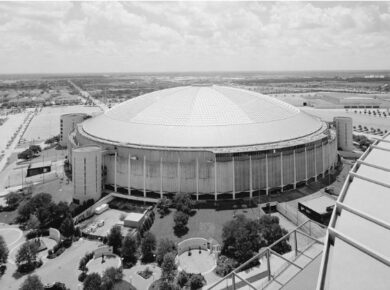Jacques Herzog (born on 19 april 1950) and Pierre de Meuron , founders of Herzog & de Meuron are known for their reappropriation of traditional architectural elements and their inventive use of both natural and artificial materials. The pair was jointly awarded the Pritzker Architecture Prize in 2001.

source: vitra.com
Their most prominent project was Tate Modern in London. To create the museum, Herzog & de Meuron converted a former power plant on the South Bank of the River Thames.
Other important projects include the Allianz Arena, a massive doughnut-shaped football soccer stadium in Munich (completed 2005); and the National Stadium (completed 2008), a dramatic steel latticework structure known as the “Bird’s Nest” that was the main arena for the 2008 Olympic Games in Beijing.
More recent projects include the R&D building for AstraZeneca and the Stade de Bordeaux, built for the European Championships of 2016.
Stade Matmut Atlantique (Bordeaux)

Photo: ©Iwan Baan
At the entrance to the stadium, a vertical forest of more than 1.000 slender posts, inspired by the Landes pine forest, immediately creates a harmonious continuity between the tree-lined square and the building. Original for a stadium, the elegant architecture is rectangular in shape. The roof is made up of 44 m cantilevered beams with a rear tie rod and a compressed post at the head of the tier. With a modular capacity of 42,000 seats in football or rugby configuration, it is also designed to accommodate a diversified programme.

Photo: ©Francis Vigouroux
But beyond its original design, it is also – and perhaps above all – because it is made of 70% steel that the New Bordeaux Stadium is unique in France.
The choice of steel is certainly no accident. The material allowed the weight of the stadium to be reduced considerably, which in turn meant that the foundations were much lighter, saving time and money. At the ends of the pitch, the north and south stands are made entirely of steel. Here again, this choice corresponds to a maximum search for lightness in order to reduce the foundations due to loose and compressible soil and the costs involved.

Photo: ©Iwan Baan
About the Author:

Bruno Dursin – Managing Director at Believe in Steel. Bruno has more than 30 years of experience in promoting steel & steel solutions. His clients benefit from his extensive network within the building industry.



